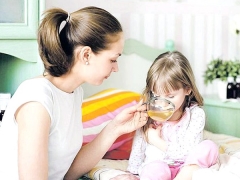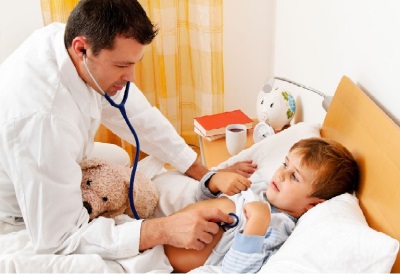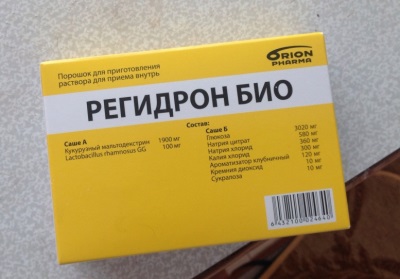What can be given to a child from vomiting?
Vomiting can occur in a child with various diseases, such as intestinal infections, flu, sore throat, meningitis, acute appendicitis, chemical poisoning or heat stroke. Treatment in all these cases is different, but there are some common points that parents should be aware of.
When should I call a doctor?
If vomiting occurs in a small child, it always scares parents and should be a reason to call a pediatrician. It is only possible to delay the request for medical care in a situation if the episode of vomiting was once, and the general condition of the baby has not been changed. In this case, you should simply observe the child.
Immediately call a doctor when vomiting occurs in such situations:
- Vomiting appeared after the fall of the child or a strong blow to the head.
- Vomiting repeated many times.
- Other symptoms of the disease, such as loose stools, fever, abdominal pain, cramps, and other warning signs, joined the attacks of vomiting.
- The child is lethargic, drowsy, reacts sharply to the light or constantly crying.
- Due to the large number of bouts of vomiting, the child does not get drunk or the child refuses to drink.
- Before vomiting, the child ate canned food or mushrooms.
- Vomiting appeared after taking any medication.
- Before the appearance of vomiting, the child overheated or was in the sun for a long time.
- The child began to show signs of dehydration.
- Blood was seen in vomitus.
What to do to stop vomiting?
Although in most cases of vomiting you need to call a doctor, parents should begin to assist the child with vomiting immediately after the onset of this discomfort symptom.
The main actions of parents should be:
- The child should be reassured, because the appearance of vomiting always scares kids. Recommended bed rest, with the head should be raised and turned on its side. If the baby is nursing, it is better to hold it vertically for some time after vomiting.
- After each episode of vomiting, you should rinse the baby’s mouth with warm clean water.
- Prior to the arrival of the doctor, the main goal of the parents should be to provide the baby with a sufficient amount of drinking, because the greatest danger of vomiting is the loss of important minerals and water by the body of the child.
- Until the cause of vomiting is established, the doctor should not give the child any medication. Also, the baby should not be temporarily fed with the exception of infants (breastfeeding or artificial feeding is not interrupted).
Liquids
Giving a child a drink is a major concern when vomiting occurs, especially if symptoms such as diarrhea and fever join (they increase dehydration).
Salt solutions are recommended for replenishing mineral waste. They alternate with the usual drink, represented by broth hips, weak tea, plain water, compote of dried fruit. Juice, carbonated drinks, milk, strong tea, broth are not recommended as drinking vomit.
Salt solutions
The best choice for drinking in the event of vomiting in a child are solutions that contain salts, since it is them that the children's body loses along with the water. Such solutions can be prepared from pharmaceutical preparations or independently.They can be given both at elevated temperatures and abdominal pains. To babies up to one year, prepared salt solutions should be diluted 1 to 1 with boiled water.
|
Name of the remedy |
Composition |
Method of preparation and dosage |
Application features |
|
Sodium chloride and citrate, dextrose, potassium chloride |
One bag diluted in hot boiled water (1 liter) and allowed to cool. Infants in the first year of life are given 5 ml each, at the age of 12-36 months - 10-15 ml each, at the age of over 3 years old - 20-25 ml at a time. |
The solution is applied after each episode of vomiting, mixing thoroughly before giving to the baby. |
|
|
On tour |
Potassium and sodium chloride, chamomile flower extract, glucose |
In hot water (200 ml) pour one bag and leave to cool. Breast babies and children under 3 years old are given 10 ml per kilogram of their weight, children older than three years old are given 100-200 ml after each episode of vomiting or loose stools. |
The solution is not sweetened. In the first four hours after vomiting, it is recommended to give up to 400 ml of solution. |
|
Humana Electrolyte |
Glucose, sodium citrate, maltodextrin, sodium chloride, potassium citrate |
A bag of the drug is dissolved in warm water (one packet is designed for 250 ml of water). Dosage means calculated depending on the weight of the child and the severity of dehydration. |
The drug is presented in two versions - with fennel (it contains fennel oil, as well as extracts of fennel and cumin) and with a banana flavor (contains natural banana flavor and sweetener acesulfame potassium). The first can be used from birth, and the second - after 3 years. Finished products can be drunk cold or warm. They do not add salt or sugar. |
|
Glucosolan |
Potassium chloride, glucose, bicarbonate and sodium chloride |
The drug is diluted in boiled water. Dosage funds for children is 10-15 ml per kilogram of child's weight. The solution is given every 5 minutes in a small amount. |
The tool is presented in two separate bags - one contains glucose, the other salt. |
|
Oralit |
Chloride and sodium bicarbonate, potassium chloride, glucose |
The bag is diluted in 250 ml of water, given in small portions every 5-10 minutes. Children under one year old are given a teaspoon, and older children are given a tablespoon of the solution. |
For newborns and premature babies, the bag needs to be diluted in twice the volume of water. |
|
Hydrovit |
Hydrocitrate and sodium chloride, dextrose citrate, potassium chloride |
The contents of the bag are dissolved in 200 ml of hot water. Children under 3 years of age are shown to use 3-5 sachets per day. Older children - 1 sachet after each episode of diarrhea or vomiting. |
On sale is also a strawberry solution, designed specifically for children. The solution can be stored in the refrigerator for up to 24 hours, at room temperature - up to one hour. |
|
Salt solution prepared by yourself at home |
Water, sugar, salt |
In a glass of water, add a teaspoon of sugar and a quarter of a teaspoon of salt. Give the child 5-10 ml every 10 minutes. |
Used as a substitute for pharmacy drugs. |
|
Salt-soda solution prepared at home |
Water, sugar, soda, salt |
In a liter of water pour eight teaspoons of sugar, a teaspoon of salt and half a teaspoon of soda. The solution is given in small portions every 5-10 minutes. |
It is a substitute for pharmaceutical solutions for rehydration. |
|
Salt-glucose solution prepared at home |
Broth raisins, salt, soda, sugar |
In a liter of water, boil 100 grams of raisins for 40 minutes. After straining (during straining the raisins should be crushed), add 4 teaspoons of sugar, half teaspoon of soda and one teaspoon of salt to the liquid. Children begin to give 5 ml each year, and older children 10 ml each. Carefully increase the portion of the time. |
It is used to replace pharmacy salt solutions and is more popular with children due to the content of raisin decoction. |
Honey. drugs
Recall that medicines, in addition to salt pharmaceutical preparations, are not recommended for a child with vomiting until the arrival of the doctor. This can be an obstacle to making the correct diagnosis. The doctor may prescribe a baby with vomiting, depending on the cause of this symptom, sorbents, zinc preparations, probiotics, antibiotics, anti-diarrhea, and other medicines.

Nutrition
Most often, vomiting attacks are accompanied by a decrease in appetite, and it is not worth insisting on feeding the child during this period. If the baby is nursing, then he should continue to breastfeed or give the usual mixture. In other cases, some time without food will only benefit the child, provided that the baby drinks enough.
As soon as the baby’s appetite improves, he can be given low-fat food, for example, crackers, rice porridge, light vegetable soup, low-fat fermented milk products. Dietary expansion should be gradual and careful.











